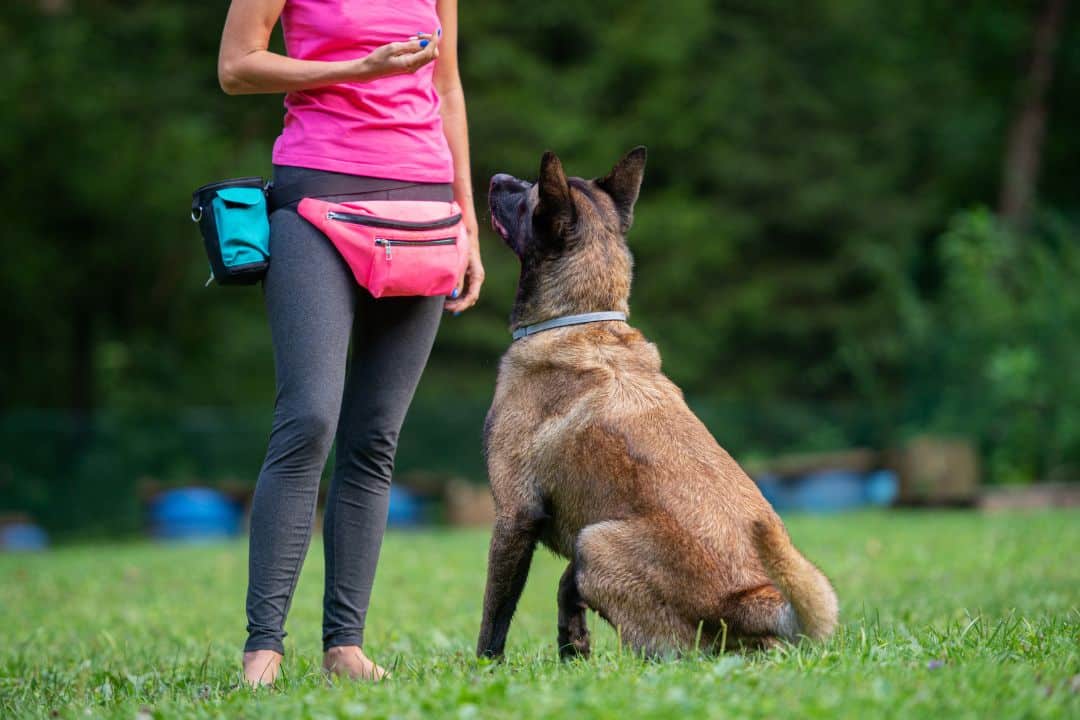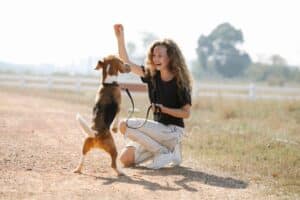
Canine agility training, or agility training for dogs, is an engaging activity that provides physical and mental stimulation for dogs while strengthening the bond between owners and their furry companions. It involves guiding dogs through obstacles such as tunnels, weave poles, and jumps, focusing on speed, accuracy, and teamwork. This article aims to provide valuable advice and tips on canine agility training for dog owners interested in outdoor activities and ensuring their pets’ well-being.
What You’ll Learn About Canine Agility Training
- Benefits, history, and evolution of canine agility training
- How to get started, training techniques, equipment, safety considerations, and competition training
- Health and fitness benefits, troubleshooting challenges, and success stories in the agility community
Definition and Benefits of Canine Agility Training
Canine agility training is a sport where a handler directs a dog through a timed obstacle course, aiming for precision and speed. This activity offers numerous benefits, including improved physical fitness, mental stimulation, increased obedience, and enhanced communication between the dog and its

owner.
Understanding Canine Agility Training
History and Evolution of Canine Agility
Canine agility training originated in England in the late 1970s as a form of entertainment at dog shows and has since evolved into a competitive sport popular worldwide.

Benefits for Dogs and Owners
Agility training provides physical exercise, mental stimulation, and an opportunity for dogs to utilize their natural instincts. For owners, it offers a means of bonding with their pets, promoting obedience, and fostering a sense of accomplishment.
How Canine Agility Training Builds a Stronger Bond
Engaging in agility training fosters trust, communication, and teamwork between dogs and their owners, strengthening the emotional connection and leading to a more harmonious relationship.
Getting Started with Canine Agility Training
Finding a Suitable Training Facility
For those new to agility training, finding a facility with experienced instructors that prioritize positive reinforcement, safety, and the well-being of the dogs is crucial.
Setting Up an Agility Course at Home
Creating a simple agility course at home using items such as cones, tunnels made from household items, and low jumps is an excellent way to introduce dogs to the basics of agility training.
Training Schedule and Commitment
Consistency is essential when embarking on agility training. Establishing a regular training schedule and dedicating time to practice is crucial for progress and success.
Training Your Dog for Outdoor Adventures
Basic Training Techniques
Teaching Fundamental Skills and Commands
Basic obedience commands such as sit, stay, and come are fundamental for agility training and form the basis for more advanced agility maneuvers.
Developing Focus, Obedience, and Confidence
Agility training helps dogs develop focus, obedience, and confidence, valuable attributes in their overall behavior and well-being.
Navigating Basic Obstacles
Introducing dogs to basic obstacles such as tunnels and low jumps in a controlled and positive environment is essential for laying a strong foundation in agility training.
| Basic Training Techniques | Advanced Training Techniques |
|---|---|
| Teaching Fundamental Skills | Mastering Challenging Obstacles and Sequences |
| Developing Focus, Obedience | Refining Speed, Accuracy, and Endurance |
| Navigating Basic Obstacles | Building Mental and Physical Stamina |
Advanced Training Techniques
Mastering Challenging Obstacles and Sequences
As dogs progress, they are introduced to more complex obstacles and sequences, which require increased coordination, speed, and decision-making skills.
Refining Speed, Accuracy, and Endurance
Training focuses on refining a dog’s speed, accuracy in maneuvering obstacles, and building endurance to sustain energy throughout a course.
Building Mental and Physical Stamina
Advanced training techniques focus on enhancing a dog’s mental acuity and physical stamina, ensuring they can perform at their best during agility courses.
Avoiding Common Dog Training Mistakes

Equipment and Tools
Overview of Different Types of Agility Equipment
Agility equipment includes tunnels, weave poles, A-frames, and various types of jumps, each designed to challenge and engage dogs in different ways.
Proper Introduction and Usage in Training
Introducing dogs to agility equipment in a positive and gradual manner is essential to prevent fear or reluctance.
DIY Agility Equipment Options and Resources
For those interested in creating agility equipment at home, numerous resources are available for DIY projects using safe and affordable materials.
Dog Leashes
Safety and Health Considerations
Warm-up Exercises, Cool Down, and Preventing Injuries
Incorporating warm-up exercises and a cool-down routine is vital in preventing injuries and ensuring the well-being of dogs during agility training.
Creating a Safe Training Environment
Prioritizing safety by maintaining well-maintained equipment, ensuring a safe training area, and monitoring for potential hazards is crucial.
Dietary and Health Considerations for Agility Training
Proper nutrition, hydration, and regular health check-ups are essential for dogs engaged in agility training to maintain their overall well-being.
Puppy Training Tips for New Owners

Training for Competitions
Understanding Competition Rules and Requirements
For those interested in competing in agility trials, understanding the rules and requirements of different organizations is essential.
Practicing Courses, Strategies, and Mental Preparation
Dedicating time to practice specific courses, developing strategies, and mentally preparing for competitions is crucial for success.
Managing Performance Anxiety and Stress
Helping dogs manage performance anxiety and stress through positive reinforcement and relaxation techniques is vital for their well-being during competitions.
Dog Collars
Bonding and Communication
Strengthening the Bond between Dog and Owner
Agility training provides an opportunity for dogs and their owners to strengthen their bond through shared experiences and mutual trust.
Improving Communication and Teamwork
The training process enhances communication and teamwork between dogs and their owners, leading to a more harmonious relationship.
Understanding and Responding to Dog’s Body Language
Learning to interpret a dog’s body language and cues is essential for effective communication and understanding during training.
Troubleshooting Challenges
Overcoming Fear, Distractions, and Training Plateaus
Addressing common challenges such as fear of obstacles, distractions, and training plateaus requires patience, consistency, and positive reinforcement.
Solutions for Common Training Obstacles
Identifying and implementing solutions for common training obstacles ensures continued progress and success in agility training.
Patience, Consistency, and Persistence in Training
Maintaining a patient, consistent, and persistent approach throughout training is key to overcoming challenges and achieving goals.
Dog Toys
Health and Fitness Benefits
Physical and Mental Benefits of Agility Training
Agility training provides dogs with physical exercise, mental stimulation, and an outlet for their natural instincts, contributing to their overall well-being.
Importance of Regular Exercise and Mental Stimulation for Dogs
Regular exercise and mental stimulation are crucial for a dog’s physical health and cognitive development, both of which are fulfilled through agility training.
Monitoring and Maintaining Your Dog’s Health during Training
Regular monitoring of a dog’s health and well-being is essential to ensure they are thriving and maintaining optimal fitness levels during agility training.
Interactive Games with Pitchdog Dog Toys

Success Stories and Community
Real-life Examples of Dogs Excelling in Agility Training
Sharing success stories of dogs excelling in agility training can inspire and motivate both new and experienced agility enthusiasts.
Testimonials and Experiences from Owners and Trainers
Insights and experiences shared by owners and trainers offer valuable perspectives and practical advice for those engaged in agility training.
Building a Supportive Canine Agility Community
Fostering a supportive and inclusive community of agility enthusiasts provides a platform for sharing knowledge, experiences, and encouragement.
Dog Toy
Real-life Success Story: Bella’s Journey to Agility Champion
Introduction
Bella, a spirited 4-year-old Border Collie, was always full of energy and enthusiasm. Her owner, Sarah, wanted to find a way to channel Bella’s energy into something positive and enriching. That’s when Sarah discovered canine agility training.
Bella’s Training Journey
Sarah and Bella started their agility training journey at a local facility. At first, Bella was easily distracted and struggled to follow commands. However, with patience and consistent training, Bella gradually began to understand the obstacles and commands.
Overcoming Challenges
As they progressed to more advanced obstacles, Bella faced new challenges. She became hesitant and fearful of certain elements on the course. Sarah worked closely with a trainer to build Bella’s confidence and trust, using positive reinforcement to help her overcome her fears.
The Triumph of Success
After months of dedicated training and hard work, Bella and Sarah entered their first agility competition. Despite initial nerves, Bella confidently navigated the course, showcasing her agility, speed, and obedience. To Sarah’s delight, Bella not only completed the course flawlessly but also won first place in her category.
Building a Supportive Community
Through Bella’s agility journey, Sarah connected with other passionate dog owners and trainers in the agility community. They shared tips, experiences, and encouragement, creating a supportive network that further fueled Bella’s progress and success.
Conclusion
Bella’s story exemplifies the transformative power of canine agility training, not only for the dog but also for the owner. It strengthened their bond, provided mental and physical stimulation, and fostered a sense of accomplishment and community. Bella’s journey is a testament to the potential and fulfillment that agility training can bring to dogs and their owners.
Conclusion and Next Steps
Canine agility training is a rewarding activity that offers numerous benefits for dogs and their owners, including physical exercise, mental stimulation, and a strengthened bond. For those interested in delving deeper into agility training, various resources are available, including books, online courses, and local training facilities.
In conclusion, canine agility training not only provides a great physical workout but also enhances the bond between dogs and their owners. By incorporating agility training into their routine, dog owners can provide their pets with a fun and engaging activity that promotes their well-being and allows them to showcase their natural skills. Whether at a professional facility or in the comfort of one’s home, agility training is a fulfilling endeavor for both dogs and their owners.
Questions
Q.Who can participate in canine agility training?
A.Any breed of dog, regardless of size or age, can participate in canine agility training.
Q.What is the purpose of canine agility training?
A.Canine agility training aims to improve a dog’s physical fitness, obedience, and mental sharpness.
Q.How can I start canine agility training with my dog?
A.You can start by researching local classes or setting up a DIY agility course in your backyard.
Q.What if my dog is not very energetic or obedient?
A.Canine agility training can help improve your dog’s energy levels and obedience through consistent practice.
Q.How long does it take to see progress in agility training?
A.Progress varies, but with regular training, you can expect to see improvement within a few weeks.
Q.What if I don’t have access to agility equipment?
A.You can make DIY agility equipment or use common household items as substitutes for official equipment.
With over a decade of experience in dog training and behavior modification, Christopher Hayes is a certified professional dog trainer and behavior consultant. They hold a Bachelor’s degree in Animal Behavior and have completed advanced courses in canine agility training and sports dog handling. Christopher Hayes has also conducted research on the impact of agility training on the physical and mental well-being of dogs, and their work has been published in reputable journals such as the Journal of Canine Sports Medicine.
As a dedicated advocate for positive reinforcement training methods, Christopher Hayes has successfully trained numerous dogs in agility, helping them develop confidence, focus, and physical stamina. Their expertise in canine agility has been sought after by dog owners and trainers alike, and they have conducted workshops and seminars on the subject, sharing their knowledge and practical insights. With a passion for promoting the bond between dogs and their owners through agility training, Christopher Hayes continues to inspire and educate dog enthusiasts around the world.
Facebook
Pinterest
Twitter
LinkedIn


